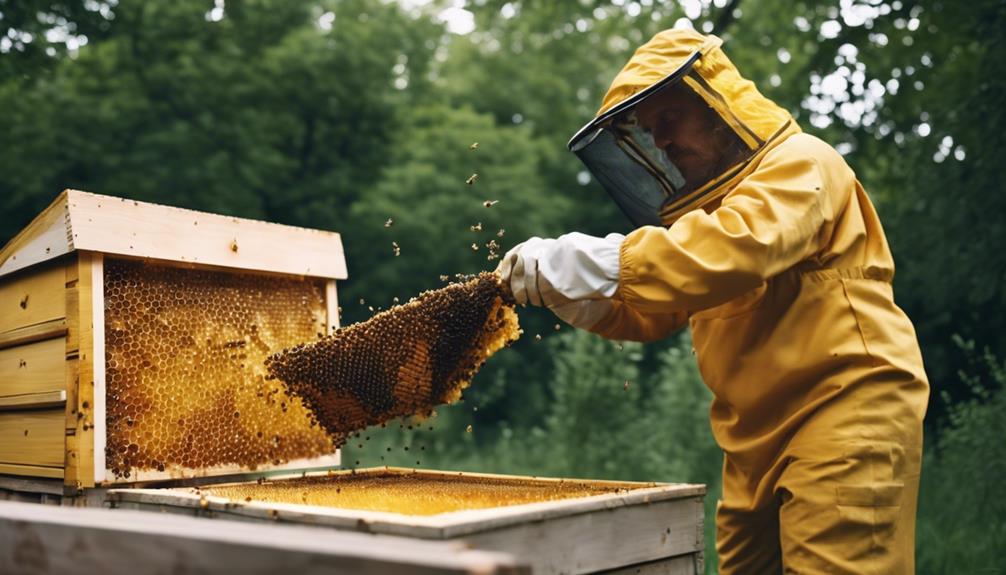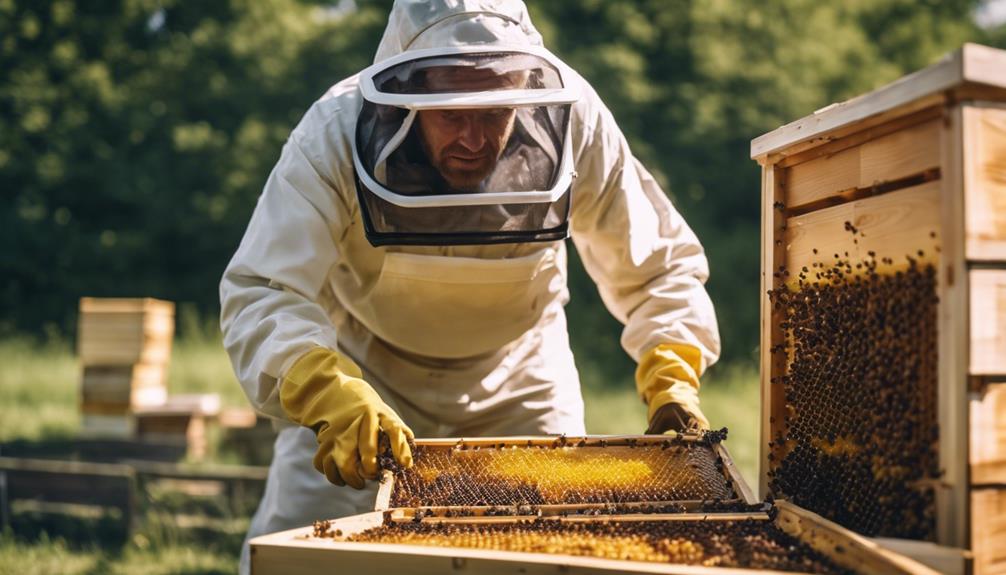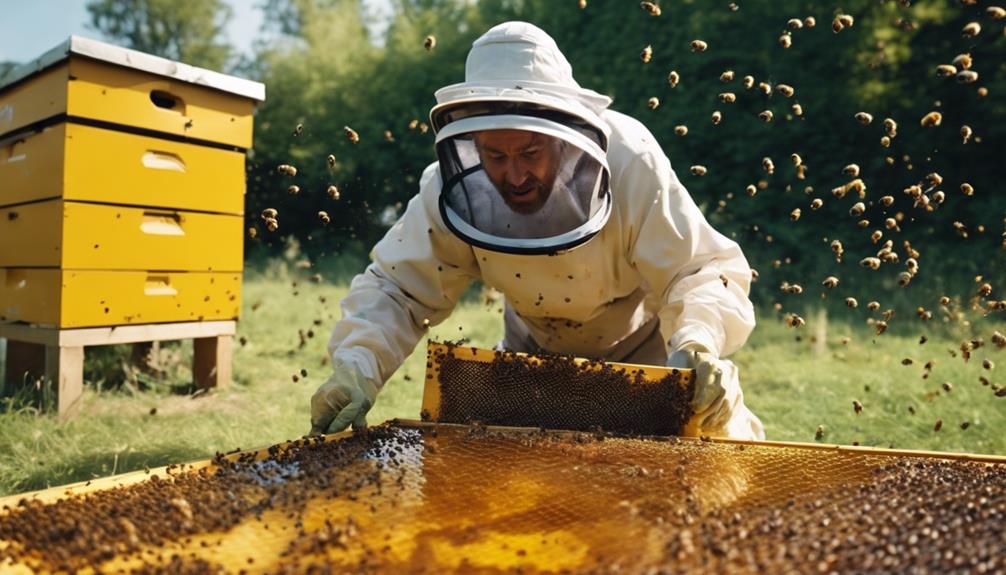So, delving into the drawbacks of a Flow Hive, we find some key concerns. To start with, there’s the hefty price tag, kicking off at around $800, which can be a real sting for commercial beekeepers or those looking to expand. The extraction process isn’t swift either, being slower and more labor-intensive compared to traditional methods. Security can also be an issue, with risks of theft and the need for extra surveillance. Inspecting the hive? Not a walk in the park due to limited access points and visibility challenges. Manual labor is another downside, especially for larger operations. These factors are essential to ponder if you’re considering a Flow Hive setup.
Main Points
- High initial cost of around $800
- Limited extraction speed
- Security concerns like theft risk
- Inspection difficulties due to design
- Manual extraction effort is labor-intensive
High Initial Cost
When starting out with a Flow Hive, we may encounter a barrier due to its high initial cost. At around $800 for a two-box setup, the Flow Hive can seem expensive, especially for beekeepers with multiple hives. Commercial beekeepers, in particular, may find the cost prohibitive compared to traditional extraction methods.
This high initial cost can be a significant investment, especially for those with larger operations. Some beekeepers view the expense of a Flow Hive as a barrier to entry or expansion in beekeeping.
While the convenience of the Flow Hive is undeniable, its cost may not always be the most cost-effective or budget-friendly option for those looking to start or expand their beekeeping endeavors.
Limited Extraction Speed
The extraction speed of the Flow Hive is significantly restricted by the time required for honey to drain from the frames. While the concept of watching honey flow directly from the hive is engaging, the reality is that this process can be slow and labor-intensive for beekeepers, especially those managing multiple hives.
This time-consuming nature might pose challenges for commercial operations that require a faster and more efficient extraction method to meet high-volume production demands. Flow Hive’s manual extraction process, although innovative, may not always align with the speed needed in large-scale beekeeping ventures.
Beekeepers looking to streamline their operations and maximize efficiency might find the limited extraction speed of the Flow Hive a drawback in meeting their commercial honey production goals.
Theft Risk

Considering the potential risk of theft associated with leaving flow frames outdoors, beekeepers must carefully strategize to protect their valuable honey resource. Safeguarding Flow Hive frames from potential theft, there are several security measures to take into account:
- Strategic Placement: Position your Flow Hive in a less visible area to deter thieves looking for easy access to honey.
- Locking Mechanisms: Utilize locks or other security devices to secure the flow frames and prevent unauthorized access.
- Surveillance: Consider installing cameras or motion sensors to monitor the hive’s surroundings and deter unwanted attention.
- Community Awareness: Engage with neighbors or local beekeeping groups to raise awareness about the potential theft risk and encourage vigilance in the area.
Inspection Challenges
Inspecting a Flow Hive can be quite the challenge regarding checking on the brood. Limited access points and hindered visibility might make it tough to keep a close eye on the health and patterns of the brood frames.
Monitoring for pests and diseases could require extra effort due to the design limitations of the Flow Hive.
Limited Access Points
Maneuvering through a Flow Hive’s limited access points presents challenges when inspecting the hive for bee health and activity. Here are some key issues beekeepers may encounter:
- Time-Consuming Inspections: Due to restricted access points, thoroughly inspecting the brood frames and ensuring hive health can be a more time-consuming task.
- Monitoring Difficulties: Limited access can hinder the ability to monitor bee activity effectively, potentially impacting the early detection of issues like diseases or pests.
- Incomplete Inspections: The design constraints might result in incomplete inspections, risking overlooking essential aspects that influence bee colony productivity.
- Maintenance Challenges: Difficulties in accessing all parts of the hive can make routine maintenance tasks more cumbersome, affecting the overall well-being of the bee colony.
Monitoring Visibility Hindered
Navigating the limited visibility within a Flow Hive poses significant challenges for monitoring bee activity effectively. When conducting hive inspections, the struggle to spot signs of disease or pests is real, hindering our ability to gauge the overall health of the colony.
Identifying issues like queen problems or irregular brood patterns becomes a challenging task due to the design limitations of the Flow Hive. Delving into individual frames or sections of the hive for specific problems requires extra effort and time, all because of the reduced visibility. It’s like trying to solve a puzzle with missing pieces, making it harder to guarantee our bees are thriving.
This limitation might require us to get creative in our inspection methods to make sure we catch any issues early on.
Manual Extraction Effort

Extracting honey from a Flow Hive demands physical exertion as we manually turn the key or crank to release the golden harvest. This labor-intensive process can be quite the workout and time-consuming, especially for beekeepers managing large-scale operations.
The effort required to shift the cells and extract honey manually might pose challenges, particularly when compared to more automated extraction methods.
Labor-Intensive Extraction Process
One must be prepared for the physical effort required when operating the Flow Hive extraction system due to its labor-intensive manual extraction process.
- Beekeepers have to manually turn the key or crank to extract honey from the Flow Frames, which can be time-consuming.
- The manual extraction process, especially for commercial-scale operations, demands significant physical effort.
- Compared to traditional methods, Flow Hive extraction may involve more mechanical effort, adding to the labor-intensive nature.
- Operating the Flow Hive extraction system requires beekeepers to engage in a hands-on, physically demanding task, emphasizing the manual effort involved in harvesting honey.
Physical Strain Involved
Turning the key or crank during manual extraction in a Flow Hive can quickly lead to physical strain for beekeepers, especially when managing multiple hives. The physical effort required for each frame can become time-consuming and labor-intensive, taking a toll on our bodies.
As we twist and turn, extracting honey frame by frame, the strain on muscles and joints adds up. While the process is satisfying, the inefficiency of manual extraction compared to automated methods might make us reconsider the workload. It’s essential to balance the joy of harvesting honey with the reality of the physical demands it places on us.
Finding ways to minimize this strain, perhaps through rotational tasks or ergonomic tools, can help us continue enjoying our beekeeping journey without feeling overwhelmed by the manual labor involved.
Capital Investment Required
Investing in a Flow Hive setup requires a capital outlay of approximately $800 for a two-box configuration, which can be a significant financial commitment for beekeepers. When considering the capital investment needed for a Flow Hive, several factors come into play:
- Commercial Operations: The cost of a Flow Hive setup may deter commercial operations due to its higher price compared to traditional extraction methods.
- Large-Scale Beekeeping: Flow Hive equipment, while innovative, can be expensive, making it less cost-effective for large-scale beekeeping ventures.
- Budget Constraints: The high initial costs of a Flow Hive could pose a challenge for beekeepers aiming to expand their operations within set budget constraints.
- Scaling Operations: The investment required for a Flow Hive setup mightn’t align with the financial capabilities of beekeepers looking to scale their beekeeping activities.
Not Suitable for All Practices

Flow Hive’s design limitations make it unsuitable for certain beekeeping practices, such as queen breeding and pollination. The challenge of inspecting brood without dismantling the hive can hinder beekeepers needing to closely monitor the health of their colonies.
Additionally, the manual extraction process in a Flow Hive may not meet the efficiency standards required by commercial beekeepers who handle large volumes of honey. For those with specific needs like queen breeding, where precise control over the hive is essential, the Flow Hive’s limited applicability presents a drawback.
While the convenience of the Flow Hive is undeniable, beekeepers must weigh this against the necessity of practices that demand more hands-on and intricate management.
Efficiency in Larger Setups
When managing multiple Flow Hives simultaneously in a larger beekeeping operation, efficiency concerns can arise due to the manual effort required for honey extraction. Here are some reasons why larger setups might find Flow Hive extraction challenging:
- Limited Extraction Speed: Flow Hives may not extract honey as quickly as traditional methods, leading to bottlenecks in high-volume production.
- Time-Consuming Process: Commercial operations aiming for efficiency may find the manual extraction process of Flow Hive to be too slow for their needs.
- Manual Effort: Large-scale beekeepers dealing with multiple hives may face physical strain and time constraints when using Flow Hive for honey extraction.
- Design Limitations: The design of Flow Hive may not be optimized for rapid extraction in settings with numerous hives, impacting overall operational efficiency.
Disassembly for Brood Inspection

Disassembling a Flow Hive for brood inspection can be quite the task. Limited access to the brood frames means we’ve to carefully dismantle the hive, which can stress out our buzzing friends.
Separating the Flow frames from the brood box is no easy feat and might disrupt the colony dynamics we work so hard to maintain.
Hive Accessibility
Inspecting the brood frames in a Flow Hive can present challenges due to limited accessibility for disassembly. When it pertains to hive accessibility for brood inspection, there are several drawbacks to take into account:
- Time-consuming Process: Disassembling a Flow Hive can be a time-consuming task, making it less convenient for frequent inspections.
- Hindered Inspections: Limited access within the hive may impede the ability to conduct thorough inspections of the brood frames, potentially missing important details.
- Disturbances to Colony: Hive disassembly for brood inspection can cause disruptions to the colony, impacting the bees’ natural rhythm and workflow.
- Stress to Bees: The process of accessing the brood frames in a Flow Hive may introduce strain to the bees, affecting their overall well-being.
Inspection Challenges
Given the challenges associated with hive accessibility in a Flow Hive, conducting thorough inspections of the brood frames can prove to be a demanding task. Dismantling the hive for brood inspection isn’t only time-consuming but also risks disrupting the colony. Limited access to the brood frames without taking apart the hive can hinder beekeepers from ensuring the health and development of the brood.
It becomes impractical to closely monitor the brood without a comprehensive inspection. The design of the Flow Hive, while innovative for honey extraction, poses obstacles in examining the brood. Beekeepers aiming for in-depth assessments of brood health may find themselves facing significant challenges due to the limitations presented by the Flow Hive structure.
Cost-Effectiveness for Commercial Use
For commercial beekeepers, the cost-effectiveness of utilizing a Flow Hive is a critical evaluation. Here are four key points to assess when evaluating the cost-effectiveness of a Flow Hive for commercial use:
- Extraction Speed: Flow Hive’s limited efficiency in extraction speed may not be suitable for large-scale commercial operations requiring quick honey harvesting.
- Cost-Effectiveness: Compared to traditional extraction methods, Flow Hive may be less cost-effective for commercial beekeepers, impacting overall profitability.
- Theft Risk: Leaving flow frames outdoors in a commercial setup may pose a potential theft risk, adding to the overall cost and security concerns.
- Mechanical Effort: The mechanical effort required for manual extraction in Flow Hive could be challenging for commercial operations seeking efficient and labor-saving extraction processes.

Hello! My name is Noel Calvin. I graduated from UCLA and now work as a writer at Launch Ninjas. I write blog posts that inspire and guide our readers in their entrepreneurial pursuits. I live in Pleasantville, NJ, with a peaceful yet lively atmosphere that inspires me.
Writing stories is more than just a job for me. It allows me to share my observations and satisfy my curiosity about the world. I combine my analytical skills with creative enthusiasm to delve into technology trends and startup stories. But my life isn’t limited to screens and keyboards. I value loyalty, passion, and a touch of old-fashioned charm, which I infuse into every narrative I create.
I love spending time in my garage, jamming with my band when I’m not writing. Playing the guitar and singing bring me immense joy. I also enjoy capturing ordinary and extraordinary moments through my camera lens and exploring new culinary adventures that excite my taste buds. I’m always seeking new experiences.
My family is very important to me. Joyful Sunday brunches filled with laughter and intense board game nights keep me grounded, reminding me of life’s simple pleasures.
In my world, every moment is an opportunity for discovery. Every discovery is a story worth sharing, whether a heartfelt moment at home or the pulse of technological innovations. Join me as I navigate through life, one blog post, one guitar strum, and one heartwarming family dinner at a time.


